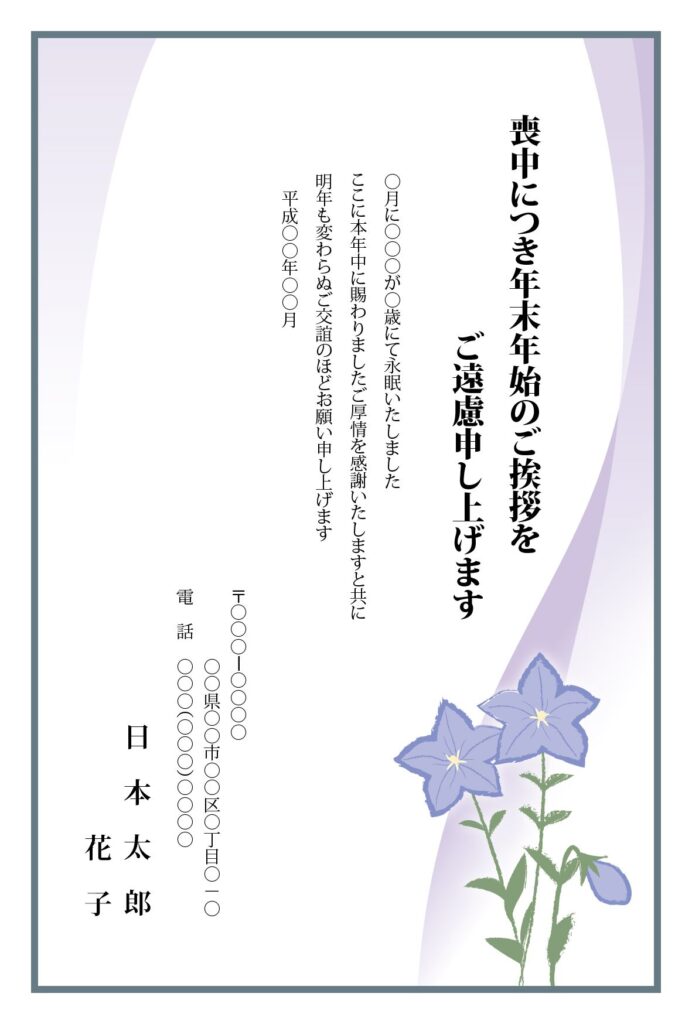Every year around this time: NOV. and Dec., I start receiving mourning postcards. It’s a sad reminder.
毎年、この時期(11月・12月)になると、喪中はがきが届きます。寂しいことです。
Do you know about “mourning postcards”? They are very important for showing consideration when welcoming the New Year.
「喪中はがき」について、知っていますか? これは新年を迎える際の配慮として非常に重要なものです。
Many Japanese language schools introduce the tradition of New Year’s cards, but they may not often explain mourning postcards.
年賀状については紹介する日本語学校も多いですが、喪中はがきについてはあまり紹介しないのではないでしょうか。
Therefore, here, I have summarized what mourning postcards are.
そこで、ここでは喪中はがきとはどういうものか、まとめました。

Rules for Mourning Postcards
In Japan, there is a custom of sending New Year’s cards called “nengajo”. Recently, with the spread of email and social media, fewer people are writing them, but this custom is still deeply rooted.
日本では新年に「年賀状」を送る習慣があります。最近はメールやSNSが広がったので、書く人もだいぶ少なくなりましたが、まだこの習慣は根強く残っています。
It’s not just among close friends, but also for relatives and old friends who live far away and whom we don’t get to see often. By exchanging these cards, we report our well-being and share the joy of the New Year.
いつも親しくしている人の間ではもちろん、普段は遠くにいてなかなか会えない親戚や旧友などと送り合うことで、お互いの無事を報告し、新年の喜びを共有するという意味もあります。
However, even if you exchange New Year’s cards every year, there are cases when you send a postcard saying “I will not send a New Year’s card next year”. This happens when a close family member has passed away during the year.
ですが、毎年年賀状を送り合う仲であっても、「来年は送りません」という場合があります。それは、自分の家族など、近い身内が年内に亡くなった場合です。
The death of a family member is a very big misfortune. Therefore, people go into mourning for a period. They quietly remember and pray for the deceased, avoiding extravagant celebrations during this time.
自分の身内が亡くなるというのは、とても大きな不幸です。そのため、人はしばらく「喪に服します」。亡くなった人を偲び、冥福を祈りながら静かに過ごします。その間は、派手なお祝い事をしないようにします。

Welcoming a new year is a joyous occasion. Sending New Year’s cards is to celebrate it. Hence, if a family member has passed away, it is customary not to send New Year’s cards the following year. The postcard that informs others of this is called a “mourning postcard”.
新しい年を迎えるというのは、慶事です。それを祝うために送るのが年賀状です。ですから、身内が亡くなったら、次の年の年賀状は出さないのが習わしなのです。そのことを知らせる葉書きが、「喪中はがき」です。
On this postcard, you write about being in mourning, apologize for not sending a New Year’s card, who passed away and when, thank them for their kindness this year, and convey greetings for the New Year.
この葉書きに書くのは、喪中であること・年賀状を出さない失礼を詫びる言葉・いつだれが亡くなったか・今年お世話になったお礼・新年もよろしくお願いしますという挨拶、などです。
This postcard will not have any extravagant patterns.
この葉書きには、派手な模様はつけません。

When you receive a mourning postcard, it’s important not to send a New Year’s card to that person. You should not send a bright card saying “Happy New Year!” to someone who is in mourning. It’s essential to show that you share their sorrow quietly.
喪中はがきをもらったら、その相手に対して自分からも年賀状を出さないことが大事なルールです。喪に服している人に、新年「おめでとう!」などと言う明るいはがきを出してはいけません。いっしょに静かに悲しみを共有する姿勢を示さなければなりません。
This is an important rule when interacting with Japanese people, so please remember it.
日本人と交際する際は、これは大事なルールなので、ぜひ覚えておきましょう。
Various Mourning Cultures Across Different Countries
I once conducted an activity in a Japanese language school where I had the students write New Year’s cards.
以前日本語学校で、「年賀状」を書かせる、という活動をしたことがあります。
A student said he wanted to write one to me, his homeroom teacher. But actually, that summer, my family member had passed away. I was a bit hesitant, but I thought it was important to teach Japanese culture, so I told the class about mourning.
そのとき、クラス担任であった私に書きたいと言ってくれた学習者がいました。でもその年の夏、実は私の家族が亡くなっていたんです。それでちょっと迷いましたが、日本の文化を教えるのも大事なことだと思い、この喪中の話をしました。
Then, the students shared the cultural practices in their own country for mourning a family member. In Nepal, after a parent passes away, men shave all their hair and beard to mourn. The world is full of diverse cultures.
すると学生たちは、自分の母国で家族を亡くした時の文化的な習慣について話してくれました。・・・ネパールでは、親が亡くなった後、男性は髪の毛や髭などすべて剃って喪に服すんだそうです。・・・世界にはいろいろな文化がありますね。

The lotus flower (In Buddhism, it is believed that Buddha sits on a lotus flower, and that lotus flowers bloom in the Pure land, where the dead move towards.)
蓮の花(仏教では、仏様は蓮の花の上にいらっしゃり、亡くなった人が向かう極楽には蓮の花が咲いていると考えられています。)


コメント